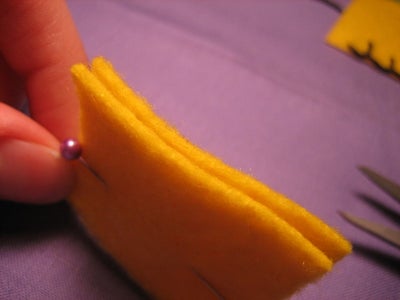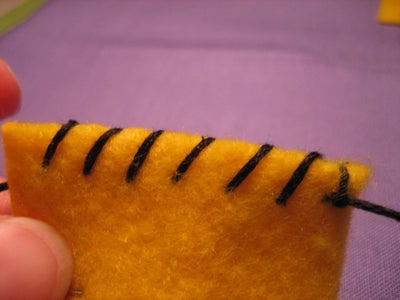Step 1: Basic Sewing Tools.

These things will make you a nice little sewing kit:
- Needles - You'll want to look for "sharps" for basic sewing. "Betweens" are used for quilting. "Embroidery" or "crewel" needles have larger eyes (an eye is the hole at the top of the needle) and are used with thicker threads, like upholstery or embroidery floss.
- Scissors - You'll want a good pair of shears (normally sold with names like "dressmaking shears") and a pair of pinking shears. Pinking shears have small triangular teeth that cut the fabric in a such a way that it lessens unraveling. Smaller embroidery scissors are also good for cutting threads.
- Pincushion & Pins - You'll pin most everything you sew to keep the fabrics from slipping. A pincushion keeps them neat and tidy.
- Measuring tape - For measuring. Air soluble/water soluble marking pens: perfect for embroidery and using patterns.
- Seam Ripper - This will help you correct mistakes.
- Beeswax - Sounds odd, I know. But essential for hand sewing. When you run your thread over the beewax, it gives the thread a nice coating that will keep it from tangling and make it stronger.
- Thimbles - These can be wood, leather or metal. They'll keep your fingers from getting sore and/or pricked.
- Thread or Floss - An all-purpose cotton thread is good for most things. However, there are many threads to choose from. You'll often pick thread based on your project - cotton fabric = cotton thread, silk = silk thread, etc. Floss is much thicker and normally comes in six-string strands. You'll use this for embroidery and finishing.
- Fabric - Might I recommend going to your local sewing store and buying some remnants to start off with? Remnants are small bits of fabric from the end of a fabric roll. They're quite cheap.
- Sewing Needle Booklet - You can either keep the packaging the needles come in or make your own! I made my own!
You can get the pattern for it here: https://www.instructables.com/id/how-to-sew-a-needle-book/, or buy one in my etsy store! You may also want to invest in an iron, self-healing cutting mat, rotary cutter, and rulers. But they're not entirely necessary. And now that we have the basics, let's thread a needle!
Step 2: Threading the Needle!
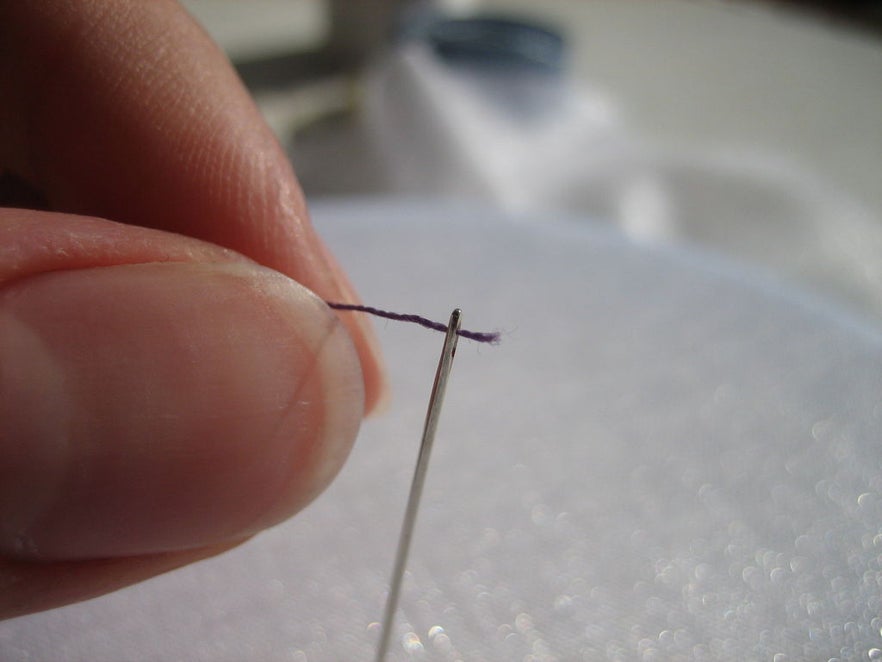
Basically, there are two ways to do this. One thread or doubled thread. I learned doubled, and that's how I do everything now. Many people also sew using a single thread so I'll teach both ways! You'll want to trim the end of the thread that will be put through the eye with very sharp scissors. This will give it a clean edge and help you ease it through the eye of the needle. If you have problems with this, you can buy a needle threader. They can be quite useful for those with bad eyes or shaky hands. Now you'll decide whether to do double or single threaded. Single threaded: pull the thread through the eye so that the needle is a few inches from the end. You can then cut the length of thread that you like. You will knot the longer single thread however you like and begin sewing. Make sure you're holding the shorter bit of thread close to the needle while sewing - otherwise, it will slip through the eye and you'll have to keep rethreading it! Double threaded: pull the thread through the eye and double it up. The end that's threaded through the eye will meet up with the thread from the spool. This way you'll have two tail ends. You'll knot these together and then sew with the doubled up thread. I find this way easier, but it's really up to you! If you're confused about how to knot the thread, see below: I find it is easiest to wind the end of the thread around one of my fingers so that it forms a loop. You can then slip that loop off your finger and pull the end through. I usually do this twice so I know the knot will stay!







Step 3: Finishing With a Knot!
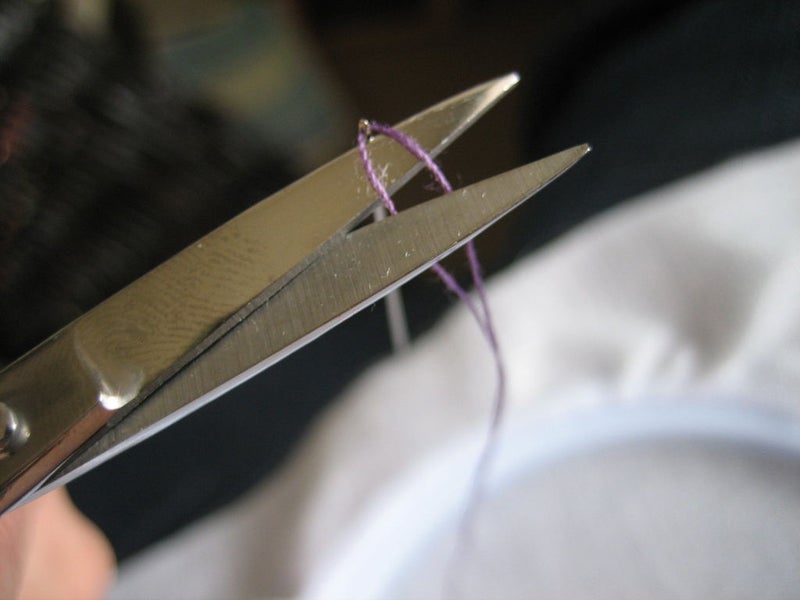
I'm going to show three ways to knot. The way you knot might depend on what you're sewing, but most of the time it will be whatever is easiest for you. Lots of pictures, I know, but the knots are color coded.
- Purple thread - Knot #1 - This is used for doubled thread. Cut the thread right below the eye of the needle. You will now have two tails. Tie these tails in a standard knot. I normally do this a few times.
- Pink thread - Knot #2 - This can be used for single or doubled thread. Hold the needle with one hand and the thread in the other. Loop the thread counterclockwise over the needle and pull it through. You'll now have the beginnings of a knot. Guide the loop down to the fabric and tighten - I normally use my finger to keep the knot in place while it tightens. Do this twice!
- Green thread - Knot #3 - You'll need to make sure you have a stitch on the back or wrong side of the fabric that's close by. Take your needle and slip it under the stitch to form a loop. Guide your needle through the loop and tighten. I normally do this two or three times.
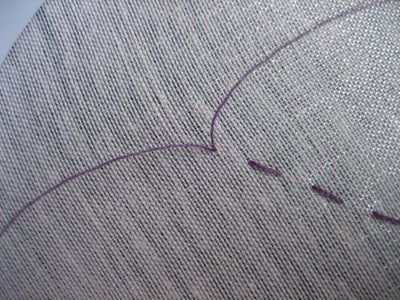








Step 4: Running & Basting Stitches.

A running stitch is the stitch most people know - the basting stitch is a longer version of a running stitch. A running stitch can be used for most anything - basting stitches are really only used to keep two pieces of fabric together for fitting, applique, or machine sewing when pins would get in the way! You'll want to start by threading your needle in one of the two ways I've taught you. Knot the thread end(s).
For the running stitch: bring your needle up through the fabric from the back (or wrong side, whichever lingo you prefer) until the knot hits the fabric. At this point, you'll simply make a stitch to the left or right of where the thread came through. Then bring the thread back up and start all over again! For the basting stitch: simply make longer stitches, between 1/4" and 1/2" in length! These are the pink stitches in the first picture. Pictures will make this easier. Follow along, now!



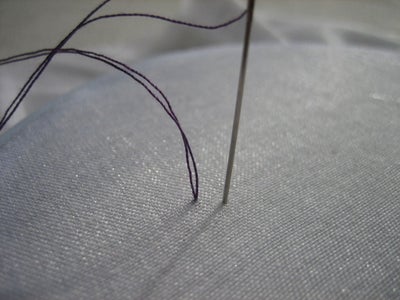



Backstitch is my absolute favorite stitch. It's smaller, stronger, and easier to keep straight than a running stitch. It is the closest to machine sewing that you can get by hand. It's also pretty simple. So thread your needle and knot the end of the threads. Bring the needle up through the back or wrong side of the fabric until you hit the knot. Take a small stitch to the right or left. When the needle goes back through the the wrong side, you'll be bringing it up through the fabric one stitch away from the last stitch. You will then push the needle through the fabric right next to the end of the first stitch. Sound confusing? Take a look at the pictures. The first two pictures show multiple ways to backstitch. You can do the stitches right next to one another or space them out.








Step 6: Slipstitching!

Learning to slip stitch is a little complicated, but it's a wonderful stitch to learn to finish your projects. Invisible stitches are the best! Slip stitching is a great way to finish small projects or project that really need to look finished and flawless. :D There are other ways, of course, but this is the main one I use. :) And once you learn to slip stitch you'll want to do it all the time. There are tons of pictures - I promise it's the best way to learn. To practice slip stitch you'll want to cut out a small square of fabric. Fold it in half and press. Open, and then fold each side into the center line. Press. Fold down center line. You'll have something that looks just like the piece of fabric I'm using. Now, thread your needle - I chose double threaded for this one because it makes it more visible! Double threading your needle will make a stronger seam, but choose single threaded if you want the stitches to be almost invisible. I'm also using purple thread, though typically you will use thread to match your fabric so it blends in. Knot it and pull the needle through the top of the fabric by sticking it through the top folded edge. Pull the thread until the knot catches. Now, move the needle to the bottom fold. You will want to stick the needle into the crease horizontally and push it along behind the fabric for about 1/4 inch. Then, pull the needle through and go back up to the top fold. Push the needle horizontally through the top fold and pull through. Continue this until the end. At the end, make a small stitch in the fold opposite of your last long stitch. Pull the thread until it forms a small loop. Put your needle through the loop twice. Pull on the thread to form a knot. Do this twice for extra staying power. The pictures at the end show what the slip stitch should look like. Pretty tiny, right? Now imagine that with matching thread! Lovely!












Step 7: Decorative Stitches!

Blanket stitch and whip stitch are used in many projects as visible seam stitches. You'll see them used on plushies, blankets. You can use them to connect two pieces of fabric or on a single piece of fabric as edging. This stitches are shown on felt. The stitches themselves are black embroidery floss (all six strands.) and they're done using an embroidery needle. As I mentioned before, you thread an embroidery needle the single thread way. The tricky part, really, is getting the floss through the eye of the needle. I always make sure to cut the end with very sharp scissors and wet the threads. (Yes, I stick the end in my mouth. You should too.) When the ends are wet, you can flatten them between your thumb and forefinger. This will lead to easier threading. But anyway... blanket stitch! Pull the thread through to the front near the edge of the fabric. Then, place the needle diagonally from where the thread is and go to the back of the fabric. As you're pulling the thread, notice that it wants to form a diagonal stitch. HO, thread! Stop right there. You're about the teach the thread a lesson. Put your needle through that loop and pull so the stitch becomes a 90 degree angle. It's easier in the pictures. But you'll continue with the diagonal stitching and pulling until you're done. At the end, take the needle and move it to the right of the last vertical line the thread forms. Bring it up through the fabric and form a loop like we've been doing. Put the needle through the loop a couple times and viola, a knot! Whip stitch is much easier. Fold a piece of fabric in half and pin it in place. Now, open the top fold and insert the needle so that it comes out the front side. Once on the front side, that the needle through the back and to the front so that it comes out level to the first stitch. Continue to do this until you come to the end. You can finish this one just like blanket stitch, honestly. Using the pictures for reference will probably help a lot. And remember that these stitches should look the same on both sides and also, I feel the overwhelming need to redirect you guys to the futuregirl pages where you can find links to AMAZING whipstitch and blanket stitch tutorials.







